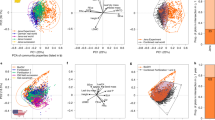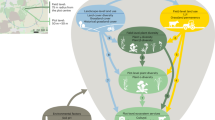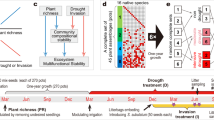Abstract
Biodiversity ensures ecosystem functioning and provisioning of ecosystem services, but it remains unclear how biodiversity–ecosystem multifunctionality relationships depend on the identity and number of functions considered. Here, we demonstrate that ecosystem multifunctionality, based on 82 indicator variables of ecosystem functions in a grassland biodiversity experiment, increases strongly with increasing biodiversity. Analysing subsets of functions showed that the effects of biodiversity on multifunctionality were stronger when more functions were included and that the strength of the biodiversity effects depended on the identity of the functions included. Limits to multifunctionality arose from negative correlations among functions and functions that were not correlated with biodiversity. Our findings underline that the management of ecosystems for the protection of biodiversity cannot be replaced by managing for particular ecosystem functions or services and emphasize the need for specific management to protect biodiversity. More plant species from the experimental pool of 60 species contributed to functioning when more functions were considered. An individual contribution to multifunctionality could be demonstrated for only a fraction of the species.
This is a preview of subscription content, access via your institution
Access options
Access Nature and 54 other Nature Portfolio journals
Get Nature+, our best-value online-access subscription
$29.99 / 30 days
cancel any time
Subscribe to this journal
Receive 12 digital issues and online access to articles
$119.00 per year
only $9.92 per issue
Buy this article
- Purchase on Springer Link
- Instant access to full article PDF
Prices may be subject to local taxes which are calculated during checkout



Similar content being viewed by others
References
Millennium Ecosystem Assessment Ecosystems and Human Well-being: Biodiversity Synthesis (World Resources Institute, Washington DC, 2005).
Butchart, S. et al. Global biodiversity: indicators of recent declines. Science 328, 1164–1168 (2010).
Maxwell, S., Fuller, R., Brooks, T. & Watson, J. Biodiversity: the ravages of guns, nets and bulldozers. Nature 536, 143–145 (2016).
Hooper, D. U. et al. Effects of biodiversity on ecosystem functioning: a consensus of current knowledge. Ecol. Monogr. 75, 3–35 (2005).
Hector, A. et al. Plant diversity and productivity experiments in European grasslands. Science 286, 1123–1127 (1999).
Tilman, D., Wedin, D. & Knops, J. Productivity and sustainability influenced by biodiversity in grassland ecosystems. Nature 379, 718–720 (1996).
Johnson, K. H., Vogt, K. A., Clark, H. J., Schmitz, O. J. & Vogt, D. J. Biodiversity and the productivity and stability of ecosystems. Trends Ecol. Evol. 11, 372–377 (1996).
Naeem, S. Ecosystem consequences of biodiversity loss: the evolution of a paradigm. Ecology 83, 1537–1552 (2002).
Loreau, M. Biodiversity and ecosystem functioning: a mechanistic model. Proc. Natl Acad. Sci. USA 95, 5632–5636 (1998).
Fetzer, I. et al. The extent of functional redundancy changes as species’ roles shift in different environments. Proc. Natl Acad. Sci. USA 112, 14888–14893 (2015).
Walker, B. H. Biodiversity and ecological redundancy. Conserv. Biol. 6, 18–23 (1992).
Allan, E. et al. More diverse plant communities have higher functioning over time due to turnover in complementary dominant species. Proc. Natl Acad. Sci. USA 108, 17034–17039 (2011).
Schwartz, M. W. et al. Linking biodiversity to ecosystem function: implications for conservation ecology. Oecologia 122, 297–305 (2000).
Srivastava, D. S. & Vellend, M. Biodiversity–ecosystem function research: is it relevant to conservation? Annu. Rev. Ecol. Evol. Syst. 36, 267–294 (2005).
Sanderson, M. et al. Plant species diversity and management of temperate forage and grazing land ecosystems. Crop Sci. 44, 1132–1144 (2004).
Zavaleta, E. S., Pasari, J. R., Hulvey, K. B. & Tilman, G. D. Sustaining multiple ecosystem functions in grassland communities requires higher biodiversity. Proc. Natl Acad. Sci. USA 107, 1443–1446 (2010).
Hector, A. & Bagchi, R. Biodiversity and ecosystem multifunctionality. Nature 448, 188–190 (2007).
Byrnes, J. E. K. et al. Investigating the relationship between biodiversity and ecosystem multifunctionality: challenges and solutions. Meth. Ecol. Evol. 5, 111–124 (2014).
Maestre, F. T. et al. Plant species richness and ecosystem multifunctionality in global drylands. Science 335, 214–218 (2012).
Isbell, F. et al. High plant diversity is needed to maintain ecosystem services. Nature 477, 199–202 (2011).
Hillebrand, H. & Matthiessen, B. Biodiversity in a complex world: consolidation and progress in functional biodiversity research. Ecol. Lett. 12, 1405–1419 (2009).
Lefcheck, J. S. et al. Biodiversity enhances ecosystem multifunctionality across trophic levels and habitats. Nat. Commun. 6, 6936 (2015).
Soliveres, S. et al. Locally rare species influence grassland ecosystem multifunctionality. Phil. Trans. R. Soc. B 371, 20150269 (2016).
Gamfeldt, L. & Roger, F. Revisiting the biodiversity–ecosystem multifunctionality relationship. Nat. Ecol. Evol. 1, 0168 (2017).
Allan, E. et al. A comparison of the strength of biodiversity effects across multiple functions. Oecologia 173, 223–237 (2013).
Roscher, C. et al. The role of biodiversity for element cycling and trophic interactions: an experimental approach in a grassland community. Basic Appl. Ecol. 5, 107–121 (2004).
Bowker, M. A., Maestre, F. T. & Mau, R. L. Diversity and patch-size distributions of biological soil crusts regulate dryland ecosystem multifunctionality. Ecosystems 16, 923–933 (2013).
Reiss, J., Bridle, J. R., Montoya, J. M. & Woodward, G. Emerging horizons in biodiversity and ecosystem functioning research. Trends Ecol. Evol. 24, 505–514 (2009).
Jax, K. Ecosystem Functioning (Cambridge Univ. Press, Cambridge, 2010).
Meyer, S. T., Koch, C. & Weisser, W. W. Towards a standardized Rapid Ecosystem Function Assessment (REFA). Trends Ecol. Evol. 30, 390–397 (2015).
Purvis, A. & Hector, A. Getting the measure of biodiversity. Nature 405, 212–219 (2000).
Hooper, D. U. & Vitousek, P. M. Effects of plant composition and diversity on nutrient cycling. Ecol. Monogr. 68, 121–149 (1998).
Dooley, Á. et al. Testing the effects of diversity on ecosystem multifunctionality using a multivariate model. Ecol. Lett. 18, 1242–1251 (2015).
Lovell, S. T. & Johnston, D. M. Creating multifunctional landscapes: how can the field of ecology inform the design of the landscape? Front. Ecol. Environ. 7, 212–220 (2009).
Foley, J. A. et al. Global consequences of land use. Science 309, 570–574 (2005).
Bullock, J. M., Aronson, J., Newton, A. C., Pywell, R. F. & Rey-Benayas, J. M. Restoration of ecosystem services and biodiversity: conflicts and opportunities. Trends Ecol. Evol. 26, 541–549 (2011).
Allan, E. et al. Land use intensification alters ecosystem multifunctionality via loss of biodiversity and changes to functional composition. Ecol. Lett. 18, 834–843 (2015).
Reyers, B., Polasky, S., Tallis, H., Mooney, H. A. & Larigauderie, A. Finding common ground for biodiversity and ecosystem services. Bioscience 62, 503–507 (2012).
Reich, P. B. et al. Impacts of biodiversity loss escalate through time as redundancy fades. Science 336, 589–592 (2012).
Oksanen, J. et al. vegan: Community Ecology Package R Package Version 2.0-10 (R Foundation for Statistical Computing, Vienna, 2013).
R Development Core Team R: A Language and Environment for Statistical Computing (R Foundation for Statistical Computing, Vienna, 2014).
Byrnes, J. multifunc: Analysis of Ecological Drivers on Ecosystem Multifunctionality R Package Version 0.6.2 (R Foundation for Statistical Computing, Vienna, 2014).
Murtaugh, P. A. In defense of P values. Ecology 95, 611–617 (2014).
Acknowledgements
We thank E. Marquard, I. Kertscher, Y. Kreutziger, S. Rosenkranz and A. Sabais for providing additional data and T. Lewinsohn for comments on the paper. We thank the gardeners, technicians, student helpers and managers of the Jena Experiment for their work. The Deutsche Forschungsgemeinschaft (FOR 456 and FOR 1451) and Swiss National Science Foundation financed the Jena Experiment.
Author information
Authors and Affiliations
Contributions
S.T.M., R.P., H.H. and W.W.W. conceived the study and developed the analytical procedure. S.T.M. and R.P. performed the analyses with contributions from W.V. All authors contributed measured data. S.T.M and W.W.W. wrote the paper. All authors contributed to writing and editing the paper.
Corresponding author
Ethics declarations
Competing interests
The authors declare no competing financial interests.
Additional information
Publisher’s note: Springer Nature remains neutral with regard to jurisdictional claims in published maps and institutional affiliations.
Electronic supplementary material
Supplementary Information
Supplementary material, Supplementary Tables, Supplementary Figures, Supplementary References
Supplementary Data 1
List of explanatory variables describing the plots of the Jena experiment. Given are plotcodes, spatial blocks, the sown species richness, the number of functional groups sown in the plot and information on the presence of individual functional groups in the plots
Supplementary Data 2
The measured values for the 82 ecosystem variables indicating functions in the 81 plots of the Jena experiment from the last year available as used in the main analyses
Supplementary Data 3
The measured values for the 54 ecosystem variables indicating functions in the 81 plots of the Jena experiment all measured in 2004 as used in a sensitivity analysis for the effect of including data on ecosystem functions measured in different years
Supplementary Data 4
Information for each ecosystem variable whether higher or lower values are considered indication of higher functioning
Supplementary Code 1
R code to calculate an index of multifunctionality using the introduced multivariate approach
Supplementary Code 2
R code to updating the turnover approach to multifunctionality to included more stringent criteria for considering an effect of an individual species informative. This allows to compensate for a high number of tests when many functions and many species are included in an analysis using the turnover approach. The code also includes analyses of simulated data to explore, based on permutation procedures, how large the potential bias in the results of the turnover approach are when using very large data sets
Supplementary Figure 1
High-resolution version of the Supplementary Figure 2.3 showing loadings of all 82 ecosystem variables on principle components of the ordination calculated in the main analysis
Supplementary Figure 2
High-resolution version of the Supplementary Figure 2.4 showing pairwise correlations between all 82 ecosystem variables included in the main analysis to indicate ecosystem functions and the calculated index of multifunctionality
Rights and permissions
About this article
Cite this article
Meyer, S.T., Ptacnik, R., Hillebrand, H. et al. Biodiversity–multifunctionality relationships depend on identity and number of measured functions. Nat Ecol Evol 2, 44–49 (2018). https://doi.org/10.1038/s41559-017-0391-4
Received:
Accepted:
Published:
Issue Date:
DOI: https://doi.org/10.1038/s41559-017-0391-4
This article is cited by
-
Stochastic community assembly of abundant taxa maintains the relationship of soil biodiversity-multifunctionality under mercury stress
Soil Ecology Letters (2024)
-
Soil microbial diversity plays an important role in resisting and restoring degraded ecosystems
Plant and Soil (2024)
-
Application of biogas-slurry and biochar improves soil multifunctionality in a poplar plantation during afforestation processes
Plant and Soil (2023)
-
Local-scale soil nematode diversity in a subtropical forest depends on the phylogenetic and functional diversity of neighbor trees
Plant and Soil (2023)
-
Influence of management and stand composition on ecosystem multifunctionality of Mediterranean tree forests
Trees (2023)



